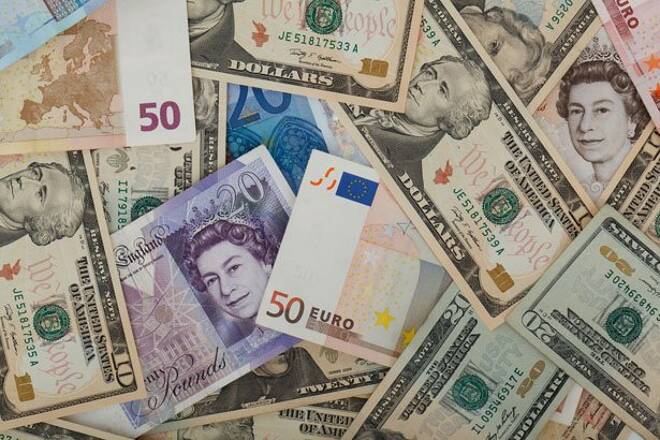Advertisement
Advertisement
EUR/USD Daily Technical Analysis for November 15, 2017
By:
The EUR/USD surged higher following a stronger than expected German GDP and solid inflation figures. This comes despite robust wholesale price inflation
The EUR/USD surged higher following a stronger than expected German GDP and solid inflation figures. This comes despite robust wholesale price inflation in the U.S. which failed to lift the greenback. Sentiment was softer than expected in Germany while U.S. same store sales fell.
Technicals
The EUR/USD surged higher rising up to resistance near the 50-day moving average at 1.1788. Support for the currency pair is seen near the 10-day moving average at 1.1646. Momentum has turned positive as the MACD (moving average convergence divergence) index recently generated a crossover buy signal. This occurs as the MACD line (the 12-day moving average minus the 26-day moving average) crosses above the MACD signal line (the 9-day moving average of the MACD line).
German Zew Was Softer than Expected
German November ZEW investor confidence nudged higher to 18.7 from 17.6 in October. The reading was below consensus, with stock market jitters and global concerns likely to have dampened what looks like a strong domestic economy. Indeed, the current conditions indicator jumped to 88.8 from 87.0 in the previous month. The overall Eurozone reading also improved further and survey data are backing expectations for ongoing robust growth in Germany and the Eurozone going ahead, especially as the ECB continues to stoke the fire with further asset purchases next year.
German Inflation Came in as Expected
German HICP inflation was confirmed at 1.5% year over year, as expected. The national rate was confirmed at 1.6% year over year. The deceleration from headline rates of 1.8% year over year for both readings in September was largely due to a deceleration in energy price inflation to just 1.2% year over year from 2.7% year over year in the previous month. Lower prices for package holidays kept the monthly rate down. The labor market is also looking tight and Germany is heading for sizeable wage growth this year, although since the last crisis wider measures of underemployment have remained higher, even as the headline rate dropped markedly.
German Q3 Was Much Higher than Expected
German Q3 GDP much higher than expected at 0.8% quarter over quarter, up from 0.6% quarter over quarter and versus a median forecast of 0.6% quarter over quarter. We even had expected a slight slowdown in the quarterly growth rate as production dynamics seemed to have slowed down temporarily, but while there is no official breakdown, the statistics office reported that net exports were a major contributor to growth in the third quarter of the year, so external demand will have compensated for the somewhat more muted performance elsewhere over the summer. The annual rate jumped to 2.8% year over year. That the German economy continues to race ahead is evident in most data and orders suggest a renewed uptick in manufacturing in the last quarter of the year with growth rates exceeding potential going ahead. The strong German data leaves overall Eurozone numbers, expected to be confirmed at 0.6% quarter over quarter and 2.5% year over year, with a slight bias on the upside.
U.S. PPI Rose in October
U.S. PPI rose 0.4% in October for both the headline and core, identical to September’s gains. The data are hotter than expected, though in part still seeing some residual impact from the disasters. Goods prices were up 0.3% last month, with energy costs unchanged while food prices were up 0.5%. September posted a 0.7% increase in goods, which were boosted by a 3.4% surge in energy, while food was unchanged. October services costs increased 0.5% following a 0.4% September gain, with trade up 1.1% from the prior 0.8%, while transportation/warehousing costs increased 0.8% versus 1.0% previously. Compared to last year, headline PPI is at a 2.8% year over year pace, the fastest since February 2012, versus September’s 2.6% year over year, while the core rate is at 2.4% year over year from 2.2% year over year previously.
U.S. Chain Store Sales Fell
U.S. chain store sales fell 0.6% in the week ended November 11, according to The Retail Economist, after inching 0.3% higher previously. Sales have been very choppy on a week-to-week basis. However, compared to the same week last year, the trend has been positive. The pace did slow to a 2.6% year over year clip in the recent week, from the prior 3.6% year over year, which was the strongest pace in about 18 months. Consumers are starting to get into the holiday shopping mood, with 45% of all consumers planning to buy gifts having reported they have begun buying such.
U.S. Business Optimism Rose
U.S. October NFIB small business optimism index rose 0.8% to 103.8 after falling 2.2% to 103.0 in September from 105.3 in August. The latter was the highest since January. Before January, the index was in the 90s since December 2014. According to the report, 35% of respondents reported that job openings they could not fill, matching the highest since November 2001. Additionally, reports of increased compensation remained strong.
About the Author
David Beckerauthor
David Becker focuses his attention on various consulting and portfolio management activities at Fortuity LLC, where he currently provides oversight for a multimillion-dollar portfolio consisting of commodities, debt, equities, real estate, and more.
Advertisement
